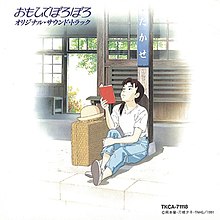| It has been suggested that this article be merged into Only Yesterday (1991 film). (Discuss) Proposed since January 2025. |
| Only Yesterday Original Soundtrack | ||||
|---|---|---|---|---|
 | ||||
| Soundtrack album by Katsu Hoshi | ||||
| Released | July 25, 1991 | |||
| Genre |
| |||
| Length | 44:12 | |||
| Language | ||||
| Label | Tokuma Shoten | |||
| Producer | Katsu Hoshi | |||
| Katsu Hoshi chronology | ||||
| ||||
Only Yesterday Original Soundtrack is the soundtrack to the 1991 Japanese animated film Only Yesterday by Studio Ghibli. It was released on July 25, 1991, by Tokuma Shoten, and the music on the album consists of several Eastern European songs, such as in Bulgarian, Hungarian, Italian and Romanian languages. The presence of music in the feature film, draws a parallel between the peasant world and Japanese rural life.
In the end credits of Only Yesterday the track "Ai wa Hana, Kimi wa Sono Tane" is played, a Japanese language version of "The Rose", performed by American singer Amanda McBroom, and in Japanese by Harumi Miyako, which was translated by Katsu Hoshi.
Background and composition
Takahata commissioned an image album from Katsu Hoshi (credited as Katz), releasing in December 1990, preceding the release of the film by nearly seven months. Hoshi and Takahata repurposed some of these songs for the film's soundtrack, while also including snippets from popular Japanese rock bands (e.g. The Wild Ones), motifs from Schubert and Brahms, and international folk music. Takahata even wrote his own translation of the pop song "The Rose", performed by enka singer Harumi Miyako. Takahata planned 'three pillars of music' for the film, the first pillar was diegetic and non-diegetic snippets of music highlighting specific moments of Taeko's flashbacks; the second pillar was Eastern European folk music such as the Bulgarian Women's Chorus and "Frunzuliță Lemn Adus Cântec De Nuntă" (Fluttering Green Leaves Wedding Song), a Romanian folk song written by Gheorghe Zamfir, using a nai played by Zamfir himself, cimbalom and violins; the third pillar was a series of introspective compositions for the piano and a small string ensemble designed to be played over scenes of Taeko's self-examination of her past. These 'three pillars' were used by Takahata to help conceptualise the film's structure of 'quotation'.
The repeated Eastern European theme in the film, particularly in the soundtrack reflecting the peasant lifestyle still present in the area draws parallels with Japanese rural life. For instance, Hungarian music in the film such as the use of Brahms' "Hungarian Dance No. 5" in a scene where Taeko is eating lunch, and making references to Hungarian musicians when she is in the car with Toshio ("Teremtés" performed by Sebestyén Márta & Muzsikás. Adaptation from a Hungarian traditional folk song). The music of Márta Sebestyén with Muzsikás is used in several scenes as well. Bulgarian folk music is also used in the soundtrack. When Taeko is on the field, one can first hear "Dilmano, Dilbero", followed by "Malka Moma Dvori Mete". These are typical Bulgarian folk songs and the lyrics of both are connected to topics mentioned in the film – the life of farmers and marriage.
Track listing
| No. | Title | Interpreter(s) | Length |
|---|---|---|---|
| 1. | "Mein Tēma (メイン・テーマ)" | 1:46 | |
| 2. | "Santora (サントラ)" | 1:20 | |
| 3. | "Maimu Maimu (マイム・マイム)" | 2:50 | |
| 4. | "Hoshinofuramenko (星のフラメンコ)" | 2:51 | |
| 5. | "O Hana-han (おはなはん)" | 1:25 | |
| 6. | "Hyokkori Hyoutanjima (ひょっこりひょうたん島)" | Yōko Maekawa | 1:04 |
| 7. | "Kokekokko no Uta (コキコッコのうた)" | Arihiro Fujimura | 0:59 |
| 8. | "Pua Bōi (プア・ボーイ)" | 1:39 | |
| 9. | "Hyokkorihyōtanjima Endingu Tēma (ひょっこりひょうたん島 エンディング・テーマ)" | 1:10 | |
| 10. | "Omoidenonagisa (思い出の渚)" | 0:42 | |
| 11. | "Tōkyō Burūsu (東京ブルース)" | 0:30 | |
| 12. | "Damatte Ore ni Tsuite Koi (だまって俺について来い)" | 0:17 | |
| 13. | "Sayonara ha Dansu no Ato ni (さよならはダンスの後に)" | 1:24 | |
| 14. | "Suki ni Natta Hito (好きになった人)" | 0:37 | |
| 15. | "Omohide Poro Poro (おもひでぽろぽろ)" | 1:02 | |
| 16. | "Teremtés" | Márta Sebestyén and Muzsikás | 4:03 |
| 17. | "Fovum Azénekem" | Sebestyén and Muzsikás | 2:11 |
| 18. | "Hajnali Nóta" | Sebestyén and Muzsikás | 2:30 |
| 19. | "Frunzulită Lemn Adus (緑の葉はそよぐ)" | Gheorghe Zamfir | 1:32 |
| 20. | "Cîntec De Nunta (結婚のうた)" | Gheorghe Zamfir | 2:49 |
| 21. | "Stornelli" | Italie Eternelle | 3:11 |
| 22. | "Ame no Benihana-zumi (雨の紅花摘み)" | 1:35 | |
| 23. | "Teema Barieeshon Abe-kun (テーマ・バリエーショオン・あべくん)" | 1:46 | |
| 24. | "Ai wa Hana, Kimi wa Sono Tane (愛は花、君はその種子)" | Harumi Miyako | 4:00 |
| Total length: | 44:12 | ||
References
- Calvario, Liz. "'Ocean Waves' Trailer: Studio Ghibli's Restored 1993 Animated Film Explores Changing Friendships". IndieWire. Retrieved March 18, 2021.
- Sutcliffe, Sophie. "Feature: Connecting with your past self as if it were Only Yesterday". Counteract. Retrieved March 18, 2021.
- "『おもひでぽろぽろ』の挿入曲にも♪ハンガリー民族音楽グループ「Muzsikás」ムジカーシュ ハンガリー/ブダペスト特派員ブログ | 地球の歩き方" (in Japanese). 地球の歩き方特派員ブログ. Retrieved March 18, 2021.
- "Recensione su Pioggia di ricordi (1991) di AndreaVenuti". FilmTV.it (in Italian). Retrieved March 18, 2021.
- "おもひでぽろぽろ【特集:ありがとう、高畑勲監督】 ‹ 上映作品 ‹ 出町座" (in Japanese). 出町座. Retrieved March 18, 2021.
- ^ Hara, Kunio (2024). "Isao Takahata and his music direction". In Pellitteri, Marco (ed.). The Palgrave Handbook of Music and Sound in Japanese Animation. Palgrave Macmillan. pp. 349–350. ISBN 978-981-97-0428-6.
This soundtrack-related article is a stub. You can help Misplaced Pages by expanding it. |